- home
- BAKERECIPES
BakeRecipes
Bringing real baking into your home with deliciously simple recipes.
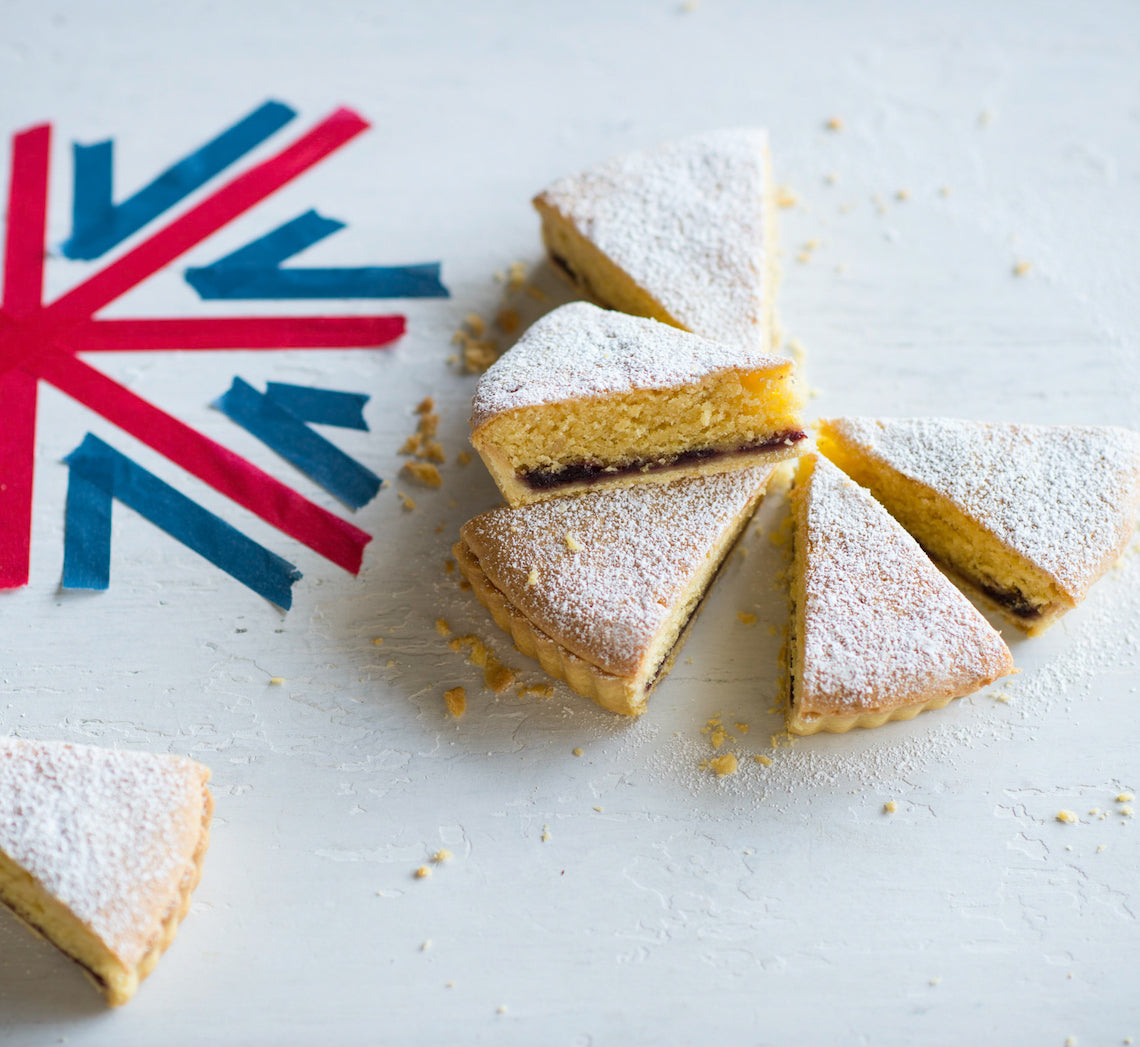
Prep 30minBake 1hr20minMakes about 8-10 serves
Bakewell tart is simply a buttery almond cake in a tart case with a welcome layer of jam in the middle. On first consideration you may not think this combination would work, but take my word for it, it does!
Ingredients
1 quantity sweet shortcrust pastry115g (⅓ cup) raspberry or cherry jam
125g unsalted butter, at room temperature
110g (½ cup) caster sugar
3 drops of almond essence or finely grated zest of 1 lemon
3 eggs
100g (1 cup) almond meal
35g (¼ cup) self-raising flour
icing sugar, to dust
Method
- Preheat oven to 200ºC (180ºC fan-forced).
- Use a lightly floured rolling pin to roll out the pastry on a lightly floured bench top to a round about 3mm thick. Carefully drape the pastry loosely around the rolling pin. Place it over an ungreased round 23cm (base measurement) tart tin with a removable base and then unroll the pastry being careful not to stretch it. Gently lift the edge of the pastry and ease it into the tart tin to line the base and sides and settle it into the corners. Use your fingertips to press it gently into the corners without stretching it. Then, working around the tin, press the pastry into the side using your thumb or finger. Roll the rolling pin over the top of the tart tin to trim any overhanging pastry.
- Place the tart tin on an oven tray. Prick the pastry base with a fork about 12 times. Line the pastry case with baking paper or foil and fill with pastry weights, dried beans or raw rice, making sure they press into the corners and they fill the case. Bake in preheated oven for 15 minutes.
- Remove the pastry case from oven and use the paper or foil to lift the weights out of the case. Return to the oven and bake for a further 15-20 minutes or until cooked through and lightly golden. Remove from the oven.
- Spread the jam evenly over the base of the tart case and set aside. Reduce the oven temperature to 160ºC (140ºC fan-forced).
- Use an electric mixer to beat the butter, sugar and almond essence or lemon zest until pale and creamy. Add the eggs one at a time, beating well after each addition. Combine the almond meal and flour, add to the butter mixture and beat on lowest possible speed until just combined. Spread the mixture evenly over the jam in the tart case.
- Bake in preheated oven for 40-45 minutes or until golden brown and a skewer inserted into the centre comes out clean. Cool in the tin for 10 minutes before removing, dusting with icing sugar and serving warm. Alternatively cool in the tin and serve at room temperature.
Baker's Tips
- This tart will keep in an airtight container at room temperature for up to 2 days.
This recipe is from Anneka's SBS Food online column, Bakeproof: Best of British Baking.
CLICK HERE for more Bakeproof recipes.
Photography by Alan Benson.
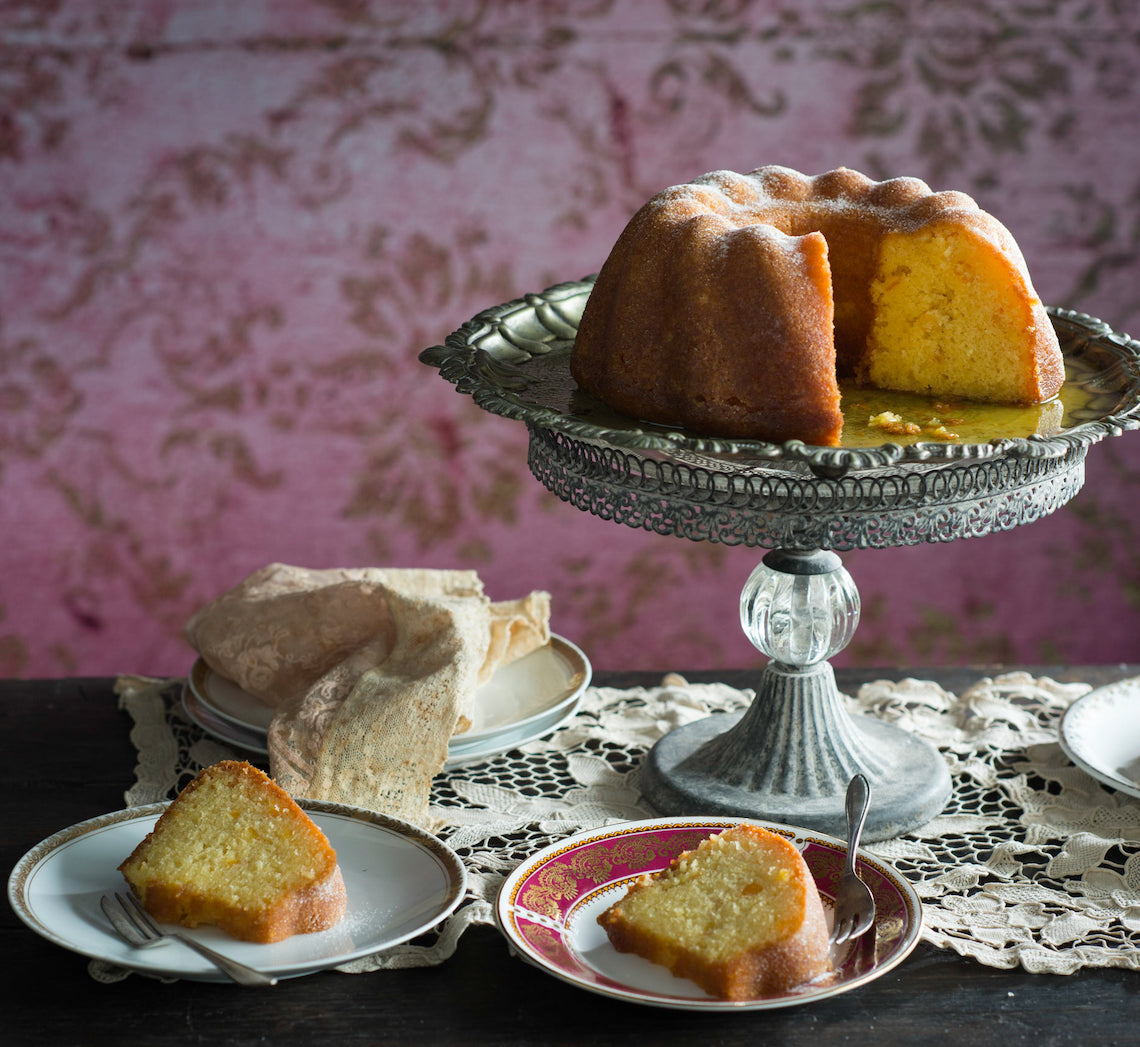
Prep 30minBake 50minMakes 12 serves
Originally a cake of the poor, Gugelhupf is a firm staple in Austria and is of the most popular afternoon tea offerings especially in the local kafes (coffee houses). But, as Emperor Franz Josef preferred, it is often eaten for breakfast. There seem to be as many variations of this yeast or sponge-based cake as there are days in the year – this one has a luscious orange syrup to keep it lovely and moist.
Ingredients
20g (¾oz) butter, melted, combined with 1½ teaspoons plain flour, to grease
250g (9oz) unsalted butter, at room temperature
125g (1 cup/4½oz) icing sugar, sifted
2 teaspoons natural vanilla essence or extract
4 eggs, at room temperature, separated
250g (1⅔ cups/9oz) plain flour, plus extra to dust
1½ teaspoons baking powder
Good pinch of salt
75g (2¾oz) candied orange rind
110g (½ cup/4oz) caster sugar, plus 1 tablespoon extra to sprinkle
Orange Syrup
250ml (1 cup/9fl oz) strained fresh orange juice
145g (⅔ cup/5oz) caster sugar
50ml (2½ tablespoons/1¾fl oz) orange liqueur
Method
- Preheat oven to 180°C/350°F (160°C/315°F fan-forced). Brush a 2.5 litre/5.25pt (24cm/ 9½in diameter) bundt tin with the melted butter and flour mixture to grease.
- Use an electric mixer to beat the butter and icing sugar and vanilla until pale and creamy. Add the egg yolks and beat until well combined and creamy.
- Sift together the flour, baking powder and salt and then stir through the candied rind. Use an electric mixer with a whisk attachment to whisk the egg whites with the salt until soft peaks form. Add the caster sugar and whisk until thick and glossy. Use a large metal spoon or spatula to fold the egg whites into the butter mixture until evenly combined. Then gently fold in the flour mixture until just combined.
- Spoon the mixture into the prepared tin and smooth the surface with the back of a spoon. Bake in preheated oven for 45-50 minutes or until a skewer inserted comes out clean. Stand in the tin for 5 minutes before turning onto a plate with a lip.
- Meanwhile, to make the Orange Syrup, combine the orange juice and sugar in a small saucepan and stir over medium heat until the sugar dissolves. Bring to a simmer and then remove from the heat. Stir in the orange liqueur.
- Slowly pour the hot syrup over the hot cake, allowing it to soak in as much as possible. Sprinkle with the extra caster sugar and cool to room temperature (this will take about 1 hour). Serve in slices for morning or afternoon tea or dessert on its own or with cream.
Baker's Tips
- This cake will keep in an airtight container at room temperature for up to 3 days.
This recipe is from Anneka's SBS Food online column, Bakeproof: Austrian Baking.
CLICK HERE for more Bakeproof recipes.
Photography by Alan Benson.
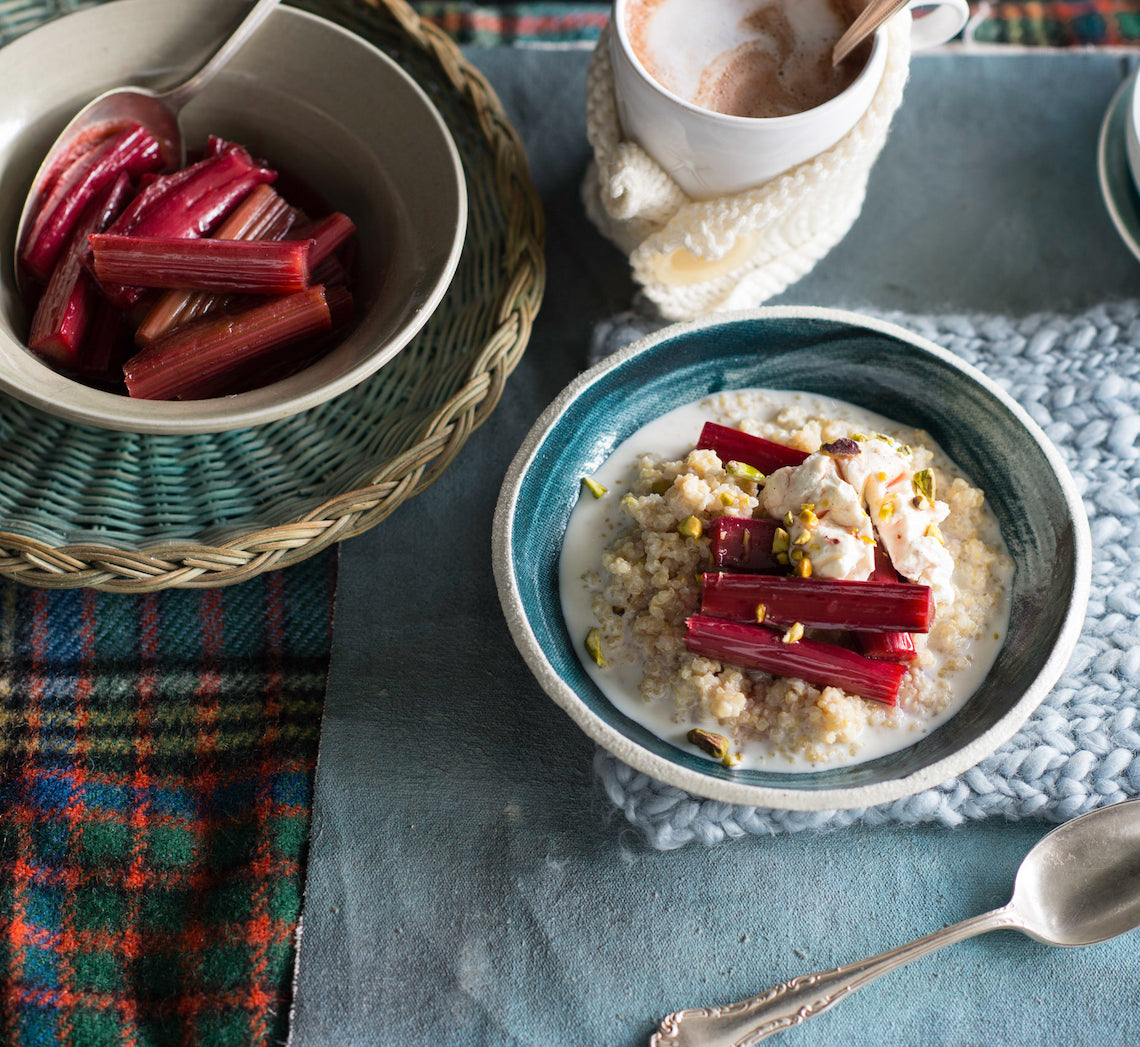
Prep 25min (+overnight standing time)Bake 55minMakes 6-8 serves
Quinoa porridge is currently the darling of the café menu. This one is a no-fuss baked version teamed with tangy rhubarb and a vanilla and honey-spiked labna, so you can enjoy this beauty without even leaving home.
Ingredients
300g (1½ cups) white quinoa
500ml (2 cups) boiling water
55g (¼ cup, firmly packed) brown sugar
1 cinnamon stick
375ml (1½ cups) milk
Toasted pistachio kernels, chopped, to serve
Vanilla-honey labna
1½ vanilla beans, split and seeds scraped
390g (1½ cup) greek-style natural yoghurt
¼ cup honey
Roasted rhubarb
550g trimmed rhubarb (about 2 bunches), cut into 6cm lengths
110g (½ cup) raw sugar
Method
- To make the Vanilla labna, place the vanilla seeds (reserve the bean for the rhubarb), yoghurt and honey in a bowl and stir to combine evenly. Line a sieve with two layers of muslin cloth or a linen tea towel and place over a bowl. Spoon the yoghurt into the sieve, fold any overhanging cloth over to enclose the yoghurt. Refrigerate overnight (at least 8 hours) to drain.
- Preheat oven to 200ºC (180ºC fan-forced). To make the Oven-baked quinoa, combine the quinoa, boiling water, brown sugar and cinnamon in a 1.5 litre capacity (6 cup) ovenproof dish. Cover with foil and bake for 30 minutes, stirring occasionally.
- Meanwhile, to make the Roasted rhubarb, rinse the rhubarb and shake off any excess water. Place in a bowl with the sugar and reserved vanilla bean and toss to combine. Transfer to an ovenproof dish just large enough to hold the rhubarb in a single layer and cover with foil.
- After the quinoa has been baking for 30 minutes, stir in the milk, cover and return to the oven with the rhubarb. Bake for another 20 minutes, stirring the quinoa 2-3 more times during baking.
- Remove the foil from the rhubarb and bake both for a further 5 minutes or until the quinoa is tender and porridge-like and the rhubarb is still holding its shape but tender when tested with a skewer.
- Immediately spoon the quinoa porridge into bowls, top with the rhubarb and pan juices, and a spoonful of labna. Sprinkle with pistachios and serve immediately.
Baker's Tips
- The rhubarb can be roasted up to 2 days before serving and kept in an airtight container in the fridge. Remove from the fridge about 1 hour before serving to bring to room temperature
- The vanilla and honey labna can be made up to 3 days before serving. Keep in an airtight container in the fridge.
This recipe is from Anneka's SBS Food online column, Bakeproof: Autumn Brunch
CLICK HERE for more Bakeproof recipes.
Photography by Alan Benson.
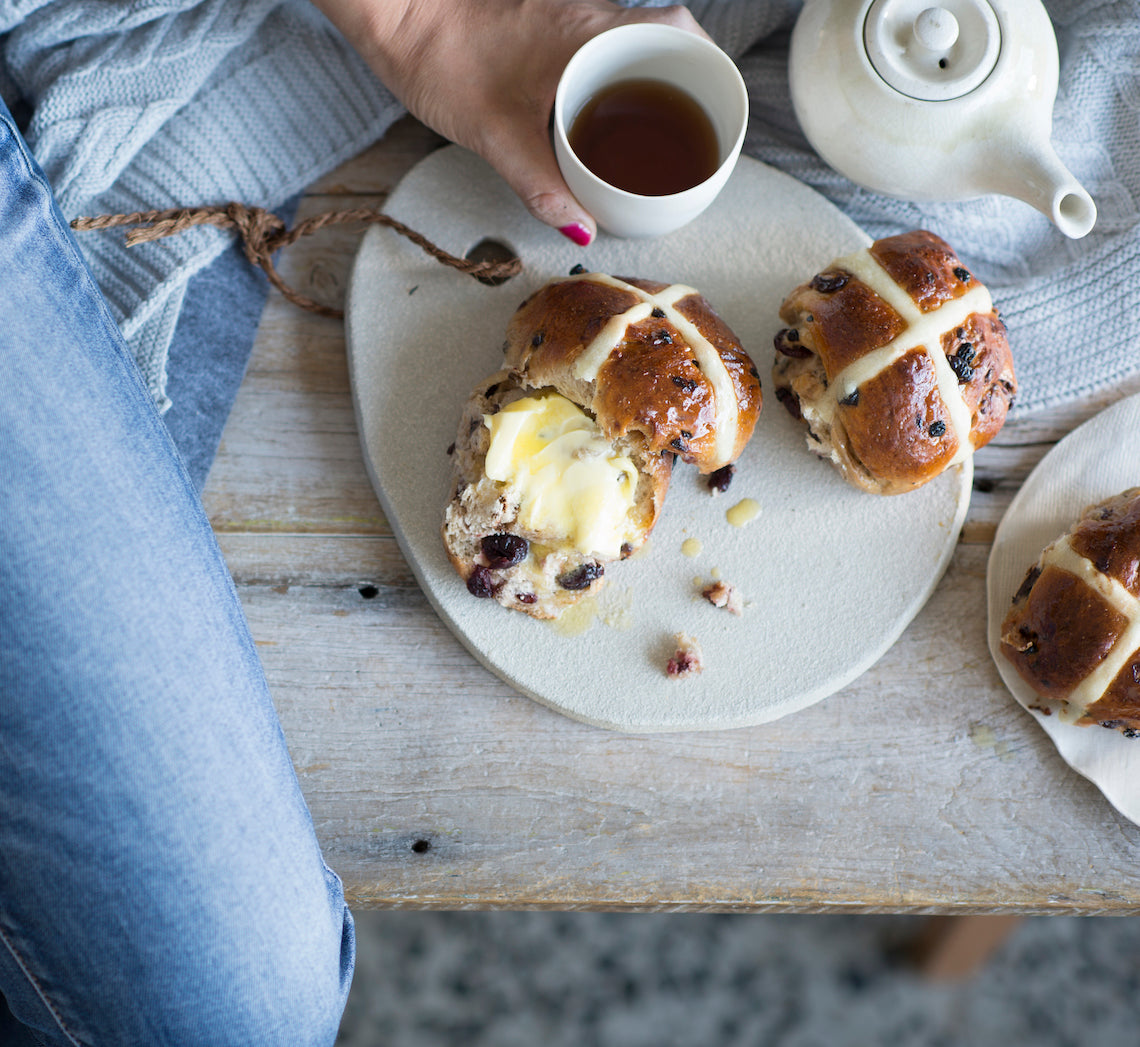
Prep 25min (+1hr 30min proving time)Bake 25minMakes 12
An updated version of the traditional favourite, these hot cross buns are studded with chunks of dark chocolate and tart, dried cherries. They're simply too hard to resist – especially when served warm with lashings of butter!
Ingredients
750g (5 cups/1lb 10½oz) strong bread or pizza (high protein) flour (see Baker's Tips)
55g (¼ cup/2oz) caster sugar
2 x 7g sachets (4 teaspoons) instant dried yeast
1½ teaspoons mixed spice
1½ teaspoons ground cinnamon
1 teaspoon salt
150g (1 cup/5¼oz) dried cherries (see Baker's Tips)
75g (½ cup/2¾oz) currants
435ml (1¾ cups/14¾fl oz) milk
60g (2fl oz) salted butter, cubed, plus extra, to grease and serve
2 eggs, at room temperature
1 teaspoon natural vanilla essence or extract
100g (3½oz) good-quality dark chocolate, chopped
Flour paste
75g (½ cup/2¾oz) plain flour
75ml (2½fl oz) water
Glaze
55g (¼ cup/ 2oz) caster sugar
2 tablespoons water
Method
- Put the bread flour, sugar, yeast, mixed spice, cinnamon and salt in a large bowl and mix to combine. Stir through the dried cherries and currants.
- Heat the milk and butter in a small saucepan over medium heat until the butter has just melted and the milk is lukewarm. Whisk one of the eggs with the vanilla and add to the milk mixture. Whisk to combine. Add to the dry ingredients and use a wooden spoon and then your hands to mix to a soft dough.
- Turn out onto a lightly floured bench top. Knead for 8-10 minutes or until smooth and elastic. Lightly grease a clean large bowl with a little butter, add the dough and turn to coat the dough. Cover with plastic wrap and set aside in a warm, draught-free place for 1 hour or until doubled in volumn.
- Line a large baking tray with baking paper. Punch the centre of the dough down with your fist. Turn onto a lightly floured bench top. Knead for 2-3 minutes or until smooth. Knead in the chocolate until evenly combined. Divide the dough into 12 equal portions. Roll each portion into a ball and place on the tray, allowing a little room for spreading. Cover with a damp tea towel and set aside in a warm, draught-free place for 30 minutes or until almost doubled in size.
- Preheat the oven to 180°C/350°F (160°C/315°F fan-forced). Meanwhile, make the Flour Paste. Combine the flour and water in a bowl and beat with a wooden spoon until smooth. Spoon into a small, good-quality snap-lock bag and seal.
- Whisk the remaining egg and brush the tops of the buns with it. Snip a small hole in the corner of the snap-lock bag containing the Flour Paste and pipe crosses on the buns.
- Bake in the preheated oven for 25 minutes or until the buns are cooked and sound hollow when tapped on the base.
- Meanwhile, make the Glaze. Combine the sugar and water in a small saucepan over medium heat and stir until the sugar dissolves. Bring to a simmer and simmer for 1 minute. Transfer the hot cross buns to a wire rack and brush the tops with the glaze. Serve warm, spread with butter.
Baker's Tips
- Bread and pizza flour (also known as 'strong' flour) has a higher gluten content than regular plain flour. This type of flour is more suited to use in yeast-based bread recipes like these buns and will give you a better final texture (the resulting bread will be more 'bread-like' with a slightly chewy texture rather than a fine, cake-like texture). Look for a protein content of around 11-13 percent for the best results with this recipe.
- Dried cherries are available at selected supermarkets, delicatessens, grocery shops and specialty food stores. You can replace them with good-quality dried cranberries.
- These hot cross buns are best eaten the day they are made although they will freeze well. To freeze, wrap in plastic wrap and then seal in an airtight container or freezer bag and freeze for up to 3 months. Thaw them at room temperature or split while still frozen and toast.
Recipe from BakeClass by Anneka Manning (Murdoch Books).
Photography by Alan Benson.
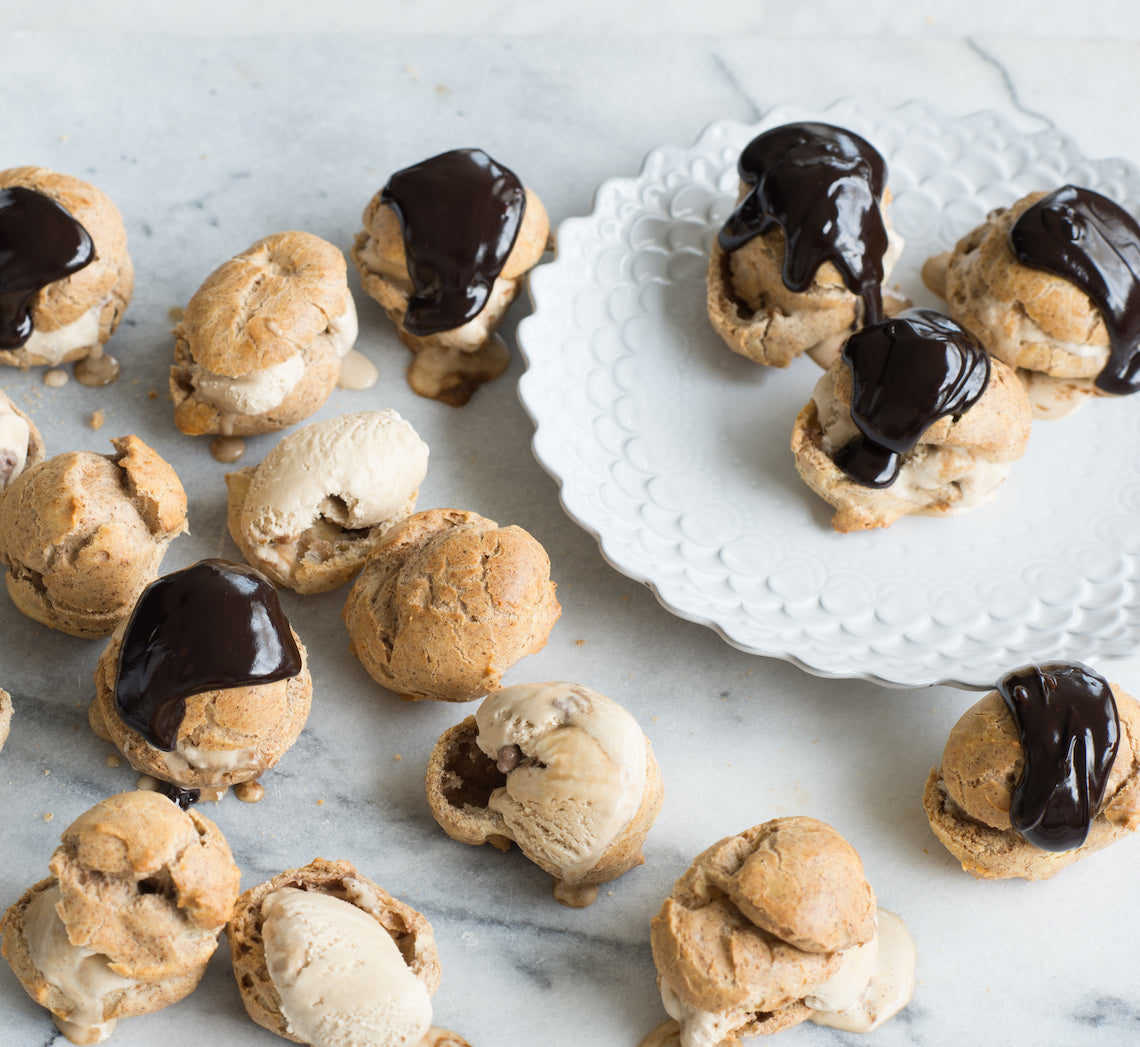
Prep 20min (+pastry making and 30min cooling time)Bake 40minMakes 10
Also called choux a la crème or cream puffs, profiteroles are basically choux pastry balls filled with crème patissiere, whipped cream or, as in these, ice-cream. These profiteroles, a heavenly combination of cinnamon, coffee and chocolate, are just a little bit addictive!
Ingredients
- 1 quantity basic choux pastry
- 2 teaspoons caster sugar
- 2 teaspoons ground cinnamon
- 1 egg, lightly whisked, to glaze
- 1 litre homemade or bought espresso or coffee ice-cream, to serve
Fudge sauce
- 200ggood quality dark chocolate (70% cocoa works well), chopped
- 125ml (½ cup) pouring cream
- 2 tablespoons golden syrup
- 1 teaspoon natural vanilla essence or extract
- ¼ teaspoon salt
Method
- Preheat oven to 200°C. Line 2 large oven trays with non-stick baking paper.
- Use a wooden spoon to beat the sugar and cinnamon into the warm prepared choux pastry until well combined.
- Spoon 30 heaped teaspoonfuls of the choux pastry onto the lined trays about 2cm apart to allow for spreading. Use a damp fingertip to smooth any peaks. Sprinkle the trays with a little water.
- Bake in preheated oven for 20 minutes or until well puffed and golden. Reduce the oven to 180°C and bake for a further 20 minutes. Turn off the oven and leave the puffs to cool in the oven for at least 30 minutes to dry. Remove from the oven and set aside to cool completely.
- Meanwhile, to make the fudge sauce, combine all the ingredients in a small saucepan and stir over low heat until the chocolate melts and the sauce is smooth. Set aside and keep warm.
- To serve, cut each of the cinnamon choux puffs in half and fill each with small scoop of ice-cream. Place three on each serving plate and spoon over the warm chocolate fudge sauce. Serve immediately.
Baker's Tips
- The cinnamon choux puffs can be made up to 3 days ahead of serving. Store in an airtight container at room temperature. Refresh by placing on an oven tray and reheating in an oven preheated to 180°C for 10 minutes. Cool, assemble and serve.
- The chocolate fudge sauce can be made up to 1 week ahead of serving. Keep in an airtight jar or container in the fridge. Reheat in a small saucepan over a low heat, stirring occasionally, until smooth and heated through.
This recipe is from Anneka's SBS Food online column, Bakeproof: Choux Pastry.
CLICK HERE for more Bakeproof recipes.
Photography by Alan Benson.
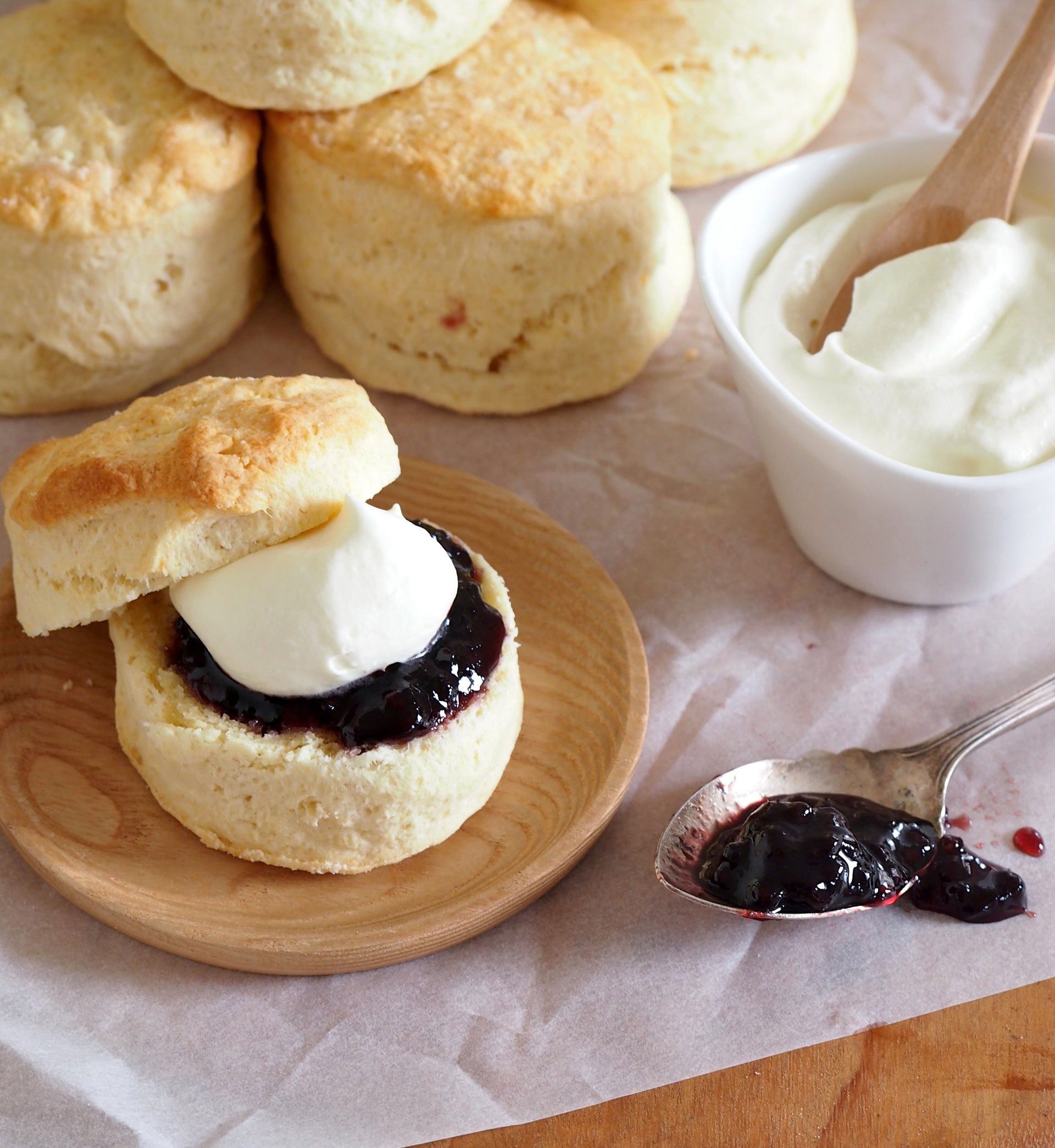
Prep 10minBake 15-18minMakes about 9
Scones are what I whip up if time is short – they are simple, fast and everyone loves them. The secret to the lightness of these scones is the surprising combination of lemonade and cream (instead of milk) – it may seem a little odd but, believe me, it works!
Ingredients
450g (3 cups) self-raising flour, plus extra, to dustPinch of Salt
80g butter, cubed, softened slightly
125ml (½ cup) lemonade, at room temperature
185ml (¾ cup) pouring cream, plus extra to glaze
Berry jam and whipped cream, to serve
Method
- Preheat the oven to 200°C. Lightly grease a baking tray with butter and then lightly dust with flour, shaking off any excess.
- Put the flour and salt in a medium bowl. Use your fingertips to rub in the butter until the mixture resembles fine breadcrumbs and the butter is evenly incorporated. Make a well in the centre.
- Combine the cream and lemonade, add to the flour mixture and use a flat-bladed knife to mix with a cutting action until the dough comes together in clumps.
- Use lightly floured hands to bring the dough together – it will be soft, but not sticky. Place on a lightly floured surface and knead lightly and briefly (only about 6 times) to bring it together in a smooth ball.
- Use the palm of your hand to flatten the dough out to about 2cm thick. Using a floured 6 cm round cutter, cut the dough into 9 rounds. Gathering the offcuts and, without over handling, pressing out as before, when necessary. Place on the prepared tray, 1-2cm apart. Use a pastry brush to lightly brush the top of each scone with a little extra cream, then dust with a little extra flour.
- Bake in the middle of the preheated oven for 15-18 minutes, until the scones are lightly golden and cooked through; they are ready if they sound hollow when you tap them on the base. Serve warm or at room temperature, split and topped with jam and cream.
Baker's Tips
- These scones are best eaten on the day they are made.
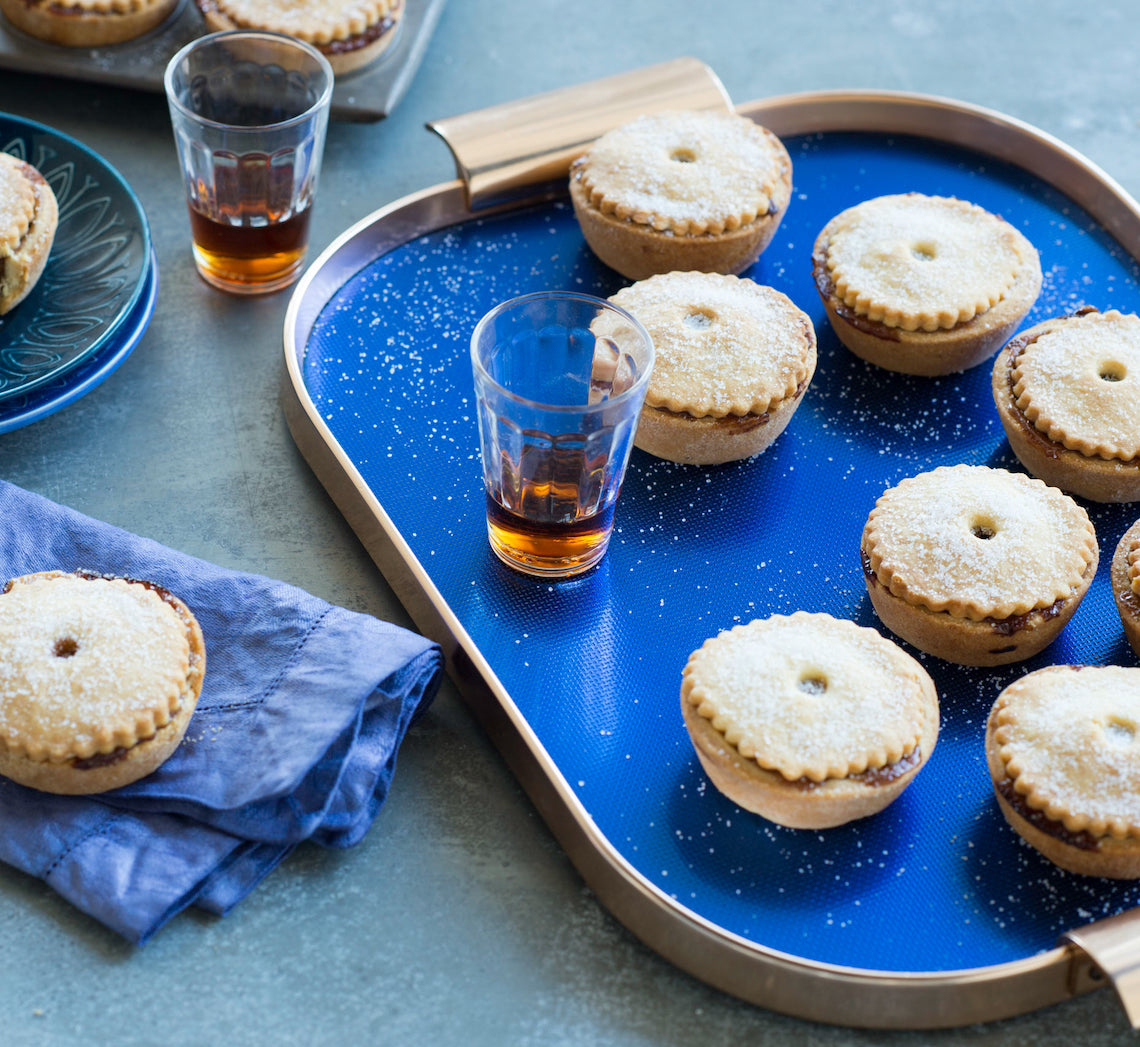
Prep 50min (+20min chilling and 50min cooling time)Bake 35minMakes about 20
According to a Middle Ages custom, if you eat a mince pie every day from Christmas day until Twelfth Night (6 January) you will have happiness for the whole year – what a wonderful excuse to indulge in these spiced, fruit-filled pies. Eat them at room temperature or straight from the oven with ice-cream, cream or brandy sauce.
You will need two 12-hole 80 ml (⅓ cup) muffin tins for this recipe.
Ingredients
Granulated sugar, to sprinkle
Fruit mince
2 small (about 150g each) Granny Smith apples, peeled, cored and coarsely grated
130 g (¾ cup) sultanas
115g (¾ cup) currants
130g (¾ cup) seedless raisins
75g (½ cup) mixed peel or chopped glace apricots
50g (⅓ cup) chopped blanched almonds
125ml (½ cup) brandy or apple cider
1 orange, zest finely grated and juiced
1 lemon, zest finely grated and juiced
2 teaspoons mixed spice
½ teaspoon ground ginger
¼ teaspoon ground cloves
100g (½ cup, loosely packed) dark brown sugar
60g unsalted butter, coarsely grated
Sweet shortcrust pastry
600g (4 cups) plain flour
125g (1 cup) icing sugar, sifted
1 teaspoon baking powder
½ teaspoon salt
300g chilled unsalted butter, diced
2 egg yolks
80-100ml iced water
Method
- To make the fruit mince, combine the grated apple, dried fruit, mixed peel, almonds, brandy or cider, orange and lemon zest and juice, and the spices in a medium saucepan. Cook over low heat, stirring occasionally for 20 minutes or until the excess liquid has evaporated. Remove from heat and set aside for 40 minutes or until cooled to room temperature.
- Meanwhile, to make the pastry, place the flour, icing sugar, baking powder and salt in a medium mixing bowl. Add the chilled butter. With your palms facing upwards, use your fingertips to rub in the butter until the mixture resembles coarse breadcrumbs. Use a fork to whisk together the egg yolks and 80 ml (⅓ cup) of the iced water and then sprinkle over the flour and butter mixture. Use a round-bladed knife in a cutting motion to mix until evenly combined and the mixture starts holding together. Press a little of the mixture between your fingers: if it holds together easily, there is no need to add more water. If it doesn’t, add the remaining 1 tbsp (20 ml) water and combine. The pastry should be soft but not sticky. Bring the pastry together with your hands and transfer to a lightly floured, cool bench top. Lightly knead the pastry with your fingertips for about 30 seconds or until smooth and soft. Divide pastry into three portions. Shape each into a disc, wrap separately in plastic wrap and place in the fridge for 20 minutes to rest.
- Preheat oven to 190°C (170°C fan-forced). Stir the sugar and butter through the cooled fruit mince.
- Use a lightly floured rolling pin to roll out one portion of the pastry to 3 mm thick. Use a 9 cm plain round cutter to cut out 10 rounds, re-rolling the offcuts if needed and line 10 x 80ml (⅓ cup) muffin tin holes, pressing into the sides and base with your fingertips (the pastry won’t reach to the top of the holes). Repeat with another portion of pastry to make another 10 pastry shells. Divide the fruit mince evenly among the pastry shells. Roll out the remaining pastry portion until 5 mm thick and use a 6.5 cm fluted round cutter to make the pie tops, re-rolling the off-cuts if needed. Use the end of a 7 mm piping nozzle to cut out a circle in the centre of each lid. Place a lid on top of each pie, and use your fingertips to gently ease the pastry out to meet the pastry case bases. Sprinkle each pie with a little granulated sugar.
- Bake in preheated oven for 35 minutes or until the pastry is deep golden and cooked through. Remove from the oven and stand in the tin for 10 minutes to cool slightly before transferring to a wire rack. Serve warm or at room temperature. Sprinkle with a little more granulated sugar, if desired.
Baker's Tips
- These pies will keep in an airtight container at room temperature for up to 1 week.
- To reheat, place the pies back in the muffin holes and place in an oven preheated to 170°C (150°C fan-forced) for 10-15 minutes or until heated through.
This recipe is from Anneka's SBS Food online column, Bakeproof: Traditional Christmas Baking. CLICK HERE for more Bakeproof recipes.
Photography by Alan Benson.
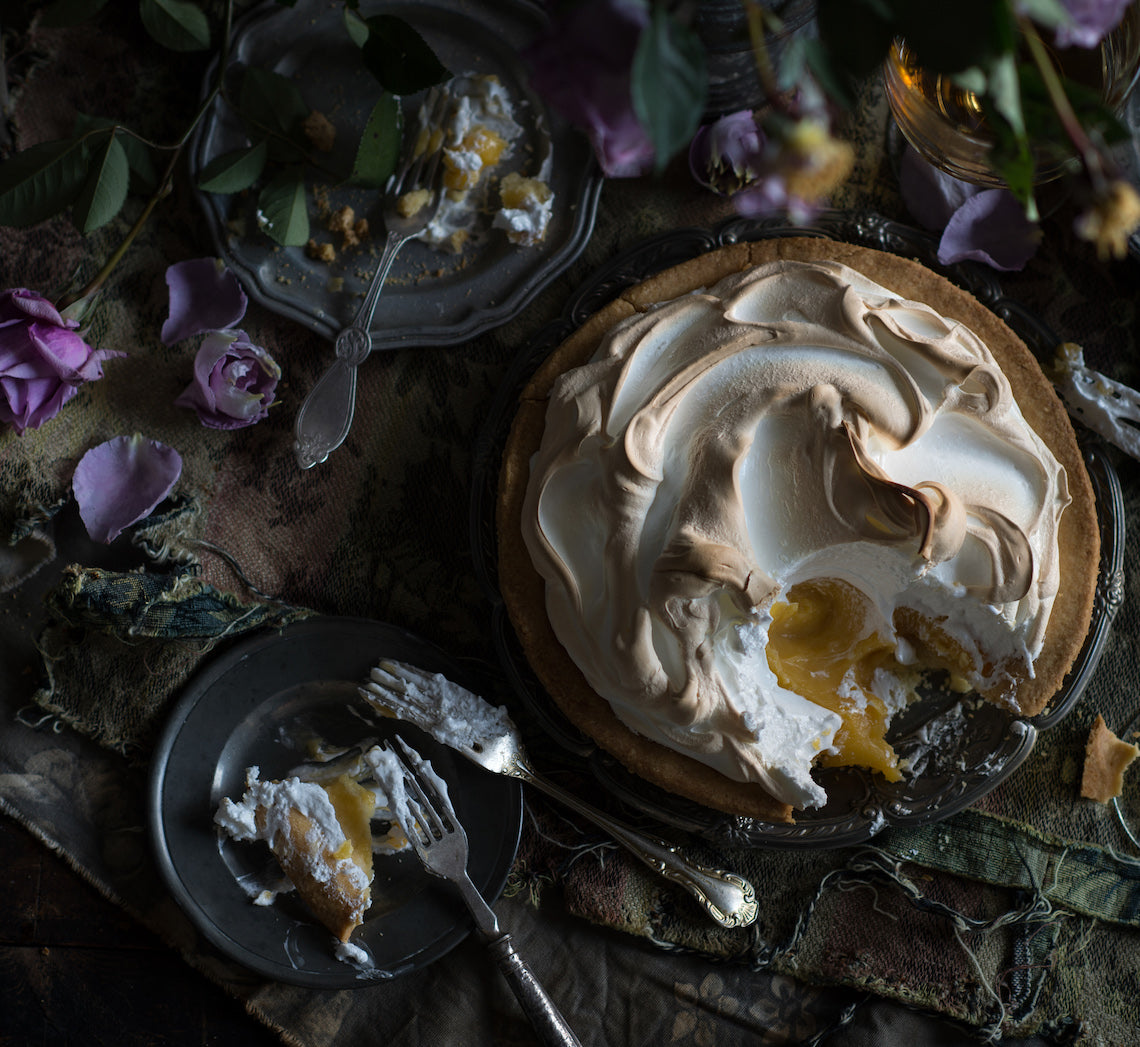
Prep 40min (+pastry making, 30min cooling and 2hr chilling time)
Bake 45-55minMakes 8-10 serves
Sometimes known as lemon chester pudding, lemon meringue pie is a wonderful combination of short, buttery pastry, a tart custard filling and a sweet, fluffy meringue topping. This recipe won’t disappoint!
Ingredients
1 quantity sweet shortcrust pastry, shaped into a disc before wrapping and chilling
Lemon Filling
40g (⅓ cup) cornflour, sifted
200ml strained freshly squeezed lemon juice
80ml (⅓ cup) water
220g (1 cup) caster sugar
6 egg yolks
100g salted butter, diced
Italian Meringue Topping
4 egg whites
220g (1 cup) caster sugar
80ml (1/3 cup) water
Pinch of salt
Method
- Preheat oven to 200°C (180°C fan-forced).
- Use a lightly floured rolling pin to roll out the pastry on a lightly floured bench top to a round about 3mm thick. Line an ungreased 22cm diameter (base measurement), 3cm deep pie plate or tart tin with the pastry. Use a small sharp knife to trim any excess pastry.
- Place the pastry case on an oven tray and use a fork to prick the base about 12 times. Line the pastry case with crumpled baking paper or foil and fill with pastry weights or raw rice, making sure they fill the case. Bake in preheated oven for 20 minutes.
- Remove the pastry case from the oven and use the paper or the foil to lift the weights out of the case. Return the case to the oven and bake for a further 20-25 minutes or until the pastry is cooked through and is golden. Set aside to cool.
- To make the Lemon Filling, place the cornflour in a medium saucepan. Use a balloon whisk to gradually stir in the combined lemon juice and water until smooth and well combined. Stir in the sugar, egg yolks and butter. Stir over medium heat for 3-5 minutes or until the butter melts. Continue to stir over medium-low heat for 5-10 minutes or until the mixture thickens and comes to a simmer. Pour immediately into the pastry shell and use the back of a metal spoon to smooth the surface. Set aside for 30 minutes to cool. Cover and chill for at least 2 hours or until the filling is set.
- When ready to serve, preheat oven to 240°C (220°C fan-forced).
- To make the Italian Meringue Topping, put the egg whites in the bowl of a stand mixer fitted with a whisk attachment. Combine the sugar and water in a small saucepan and stir with a wooden spoon or spatula over low heat until the sugar dissolves. Increase the heat to medium and bring to the boil. Boil for about 10 minutes, occasionally brushing down the side of the pan with a pastry brush dipped in water to dissolve any sugar crystals, until the syrup reaches soft ball stage (115°C on a sugar thermometer). Meanwhile, just before the syrup is ready, whisk the egg whites on high speed until firm peaks form. Remove the syrup from the heat and stand for about 1 minute or until the bubble subside. With the motor running on high speed, gradually add the sugar syrup in a thin steady stream until all the syrup has been incorporated. Add the salt and then continue to whisk on medium speed for another 10 minutes or until the meringue has cooled to room temperature.
- Spread the meringue mixture over the top of the lemon filling, swirling as desired. Bake in preheated oven for 5-10 minutes or until browned on the edges (see Baker’s Tips). Stand for 5 minutes before scooping with a large metal spoon or cutting into wedges with a sharp knife that has been dipped in hot water (see Baker’s Tips).
Baker's Tips
- This pie is best eaten the day it is made.
- If using a tart tin, you can transfer the pastry case to a ovenproof serving plate before adding the filling.
- You can also use a blowtorch to caramelise the meringue topping instead of returning it to the oven in step 7.
- Dipping the spoon or knife in hot water and drying before scooping or cutting will make it easier to portion.
This recipe is from Anneka's SBS Food online column, Bakeproof: Citrus.
CLICK HERE for more Bakeproof recipes.
Photography by Alan Benson.
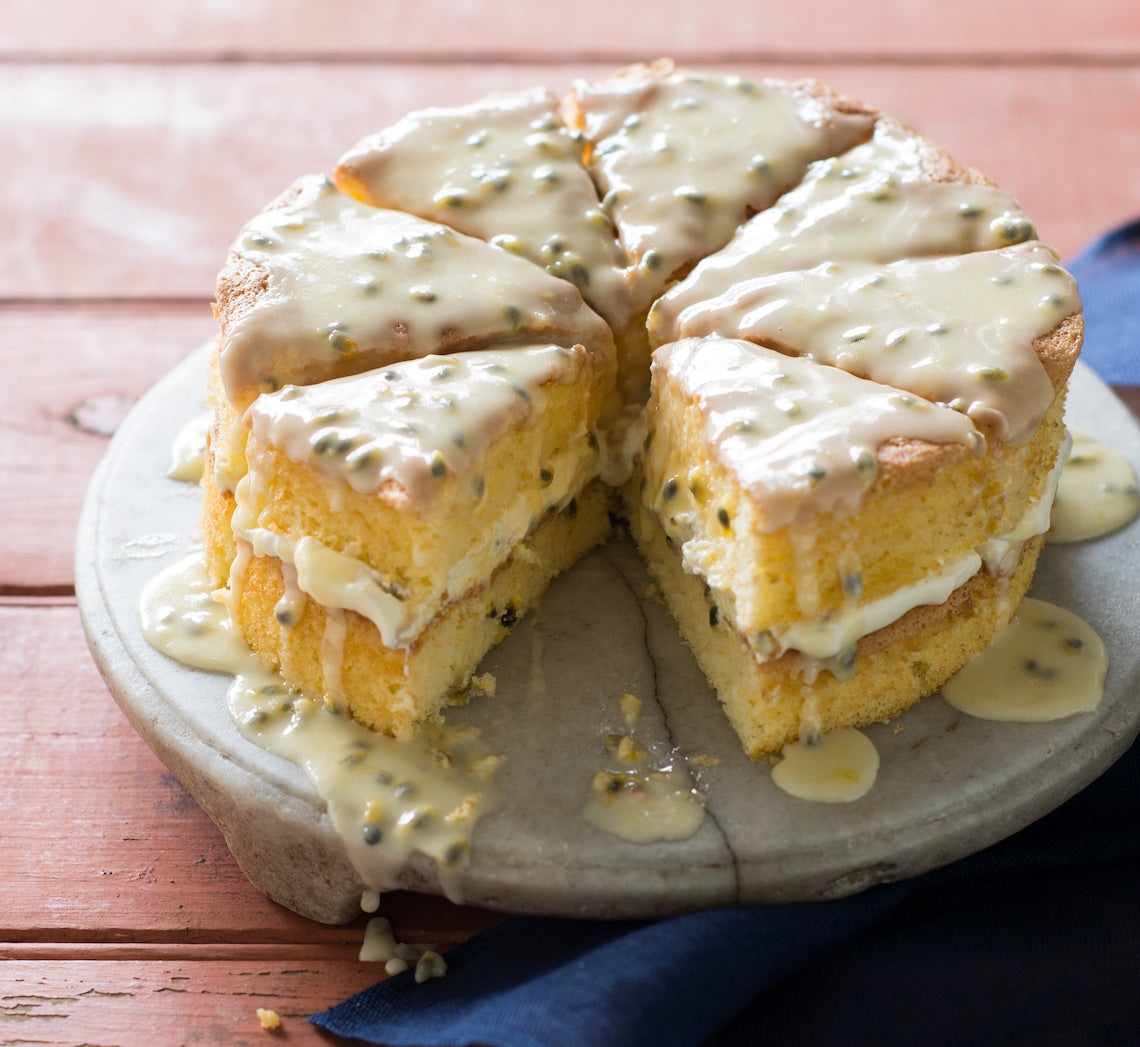
Prep 25min (+cooling time)Bake 18-20minMakes 8-10 serves
This sponge will have you wanting an excuse to make afternoon tea every day. There are two main tricks when making a sponge: don’t over-whisk the mixture once you have added the flour – only whisk it until the mixture is just combined. Also, sponges don’t take long to bake and, if overcooked, will easily become dry, so keep a close eye on them when baking.
Ingredients
160ml (⅔ cup/5¼fl oz) thickened cream
80ml (⅓ cup/2½fl oz) fresh passionfruit pulp
Sponge Layers
Melted butter, to grease
4 x 60g (2oz) fresh eggs, at room temperature
165g (¾ cup/5¾oz) caster sugar
60ml (¼ cup/2fl oz) milk
30g (1oz) salted butter, diced
110g (¾ cup/4oz) self-raising flour, plus extra to dust
30g (¼ cup/1oz) cornflour
Passionfruit Icing
180g (1½ cups/6½oz) pure icing sugar
1½ tablespoons fresh passionfruit pulp
Approx. 3 teaspoons boiling water
Method
- To make the Sponge Layers, place the oven rack in the lower third of the oven and then preheat it to 180°C/350°F (160°C/315°F fan-forced). Brush two 20cm/8in shallow (sandwich) cake tins with a little melted butter to lightly grease. Line the bases with circles of baking paper. Lightly brush the paper with a little more melted butter and then dust the bases and sides of the tins with a little flour to lightly coat, tapping out any excess.
- Use an electric mixer with a whisk attachment on medium-high speed to whisk the eggs in a medium bowl until frothy. Add the sugar a spoonful at a time, whisking well between each addition, until the mixture is very thick and pale and the sugar has dissolved (this will take about 8 minutes). Lift the whisk out of the mixture and draw a figure eight, if the trail stays on the surface long enough for you to finish drawing then the mixture is ready. If not, continue to whisk for a further minutes and then test again.
- Meanwhile, heat the milk and butter in a small saucepan over medium heat until the butter melts and the mixture is almost simmering. Remove from the heat. Pour the hot milk mixture down the side of the bowl with the egg mixture. Quickly sift the flour and cornflour together over the egg mixture and then immediately whisk again with the electric mixer briefly, until the flour mixture is just incorporated (make sure there is no flour caught at the bottom of the bowl and be careful not to overmix).
- Divide the mixture evenly between the cake tins (see Baker’s Tips) and gently tap the tins on the bench top three times to settle the mixture. Bake in preheated oven for 18-20 minutes or until the cakes are a pale golden colour, spring back when lightly touched in the centre and start pulling away from the sides of the tins. Remove from the oven and stand for 1 minute before turning onto a wire rack, top side up (see Baker’s Tips), to cool completely.
- When ready to fill, to make the Passionfruit Icing, sift the icing sugar into a medium bowl. Add the passionfruit pulp and enough boiling water to mix to a thin, spreadable icing. Cover tightly with plastic wrap and set aside. Use an electric mixer with a whisk attachment or a balloon whisk to whisk the cream in a medium mixing bowl until soft peaks form. Use a large metal spoon or spatula to gently fold the passionfruit pulp through the whipped cream until just swirled through. Place one layer of the sponge on a serving plate or cake stand and spread with the passionfruit cream. Top with the remaining sponge layer. Spread the Passionfruit Icing evenly over the top layer of the sponge, allowing it to drip down the sides slightly. Set aside or 20 minutes or until the icing sets before serving in slices.
Baker's Tips
- You will need about 5 large passionfruit for this recipe.
- To divide the mixture evenly between the tins, weigh the tins with the mixture in them to make sure they are the same weight.
- When removing the cakes from the tins, turn them onto a wire rack covered with a tea towel before inverting onto another rack. The tea towel will prevent the rack marking the tops of the cakes.
- The unfilled sponge cakes will keep in an airtight container at room temperature for up to 1 day. Once filled, the cake will keep in an airtight container in the fridge for up to 2 days. Stand at room temperature for at least 30 minutes before serving.
This recipe is from Anneka's SBS Food online column, Bakeproof: Sponge Cake.
CLICK HERE for more Bakeproof recipes.
Photography by Alan Benson.
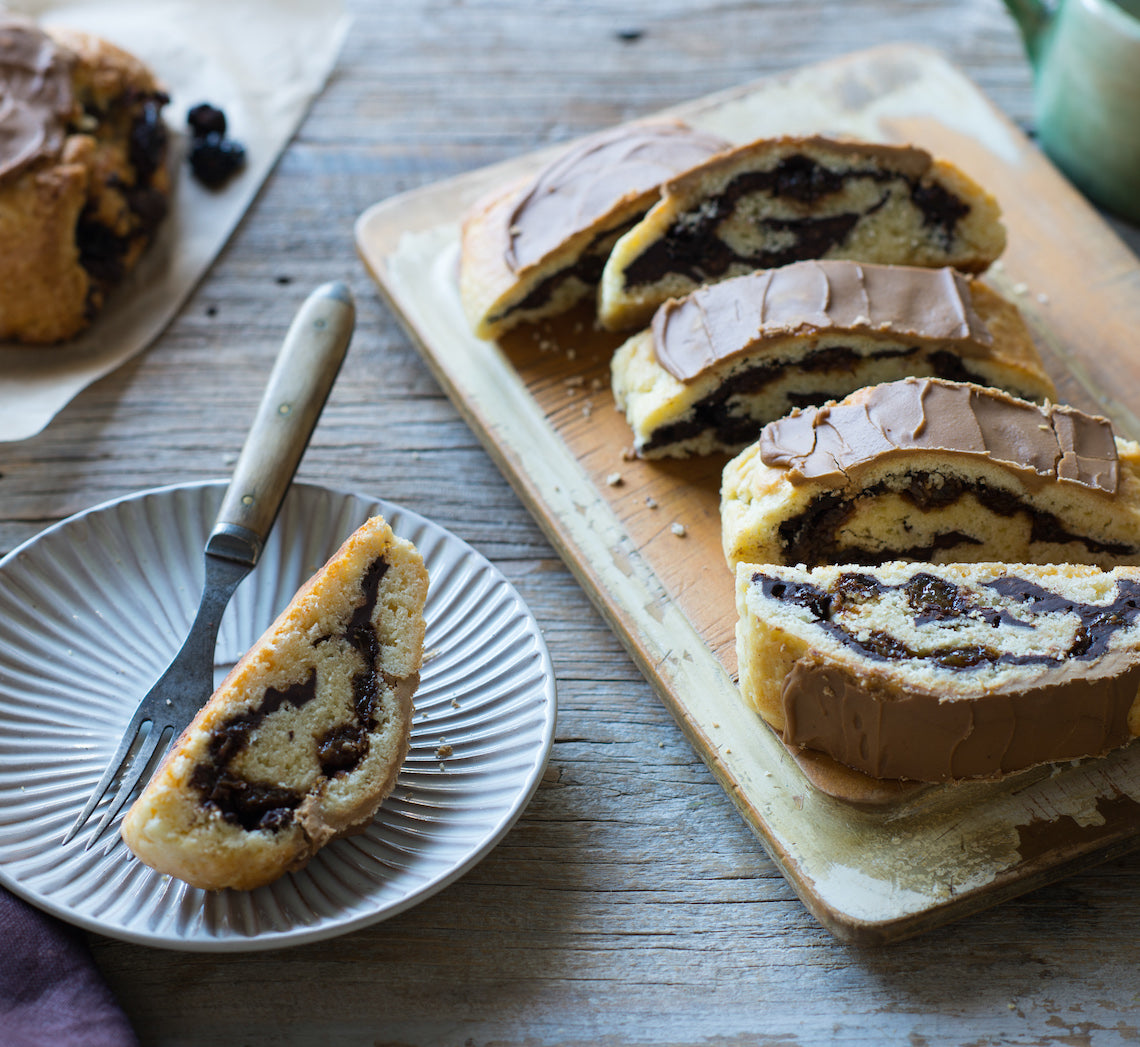
Prep 30min (+30min standing time)
Bake 40min Makes about 24
Even though these rolls are based on a scone dough, they resemble more a cakey biscuit. Confused? Just go ahead and bake them, you won't be disappointed… And you'll probably find yourself sneaking an extra slice!
Ingredients
170g (1 cup) seedless raisins
60ml (¼ cup) freshly brewed strong coffee
225g (1½ cups) self–raising flour
75g (½ cup) plain flour
Pinch of salt
80g butter, softened slightly, cubed
2 tablespoons caster sugar
125ml (½ cup) pure (pouring/thin) cream
80ml (⅓ cup) milk, plus extra for glazing
150g good-quality dark chocolate, chopped
Coffee icing
125g (1 cup) pure icing sugar
1 tablespoon freshly brewed strong coffee
Method
- Preheat the oven to 180°C (160°C fan-forced). Line a large baking tray with non–stick baking paper.
- Put the raisins and coffee in a small saucepan and bring to a simmer over medium heat. Remove from the heat and set aside for 15 minutes or until almost all the liquid has been absorbed. Drain the raisins and set aside.
- Sift both the flours and salt together into a medium bowl. Use your fingertips to rub in the butter until the mixture resembles fine breadcrumbs and the butter is evenly incorporated. Stir in the sugar and make a well in the centre. Combine the milk and cream, add to the flour mixture and use a flat-bladed knife to mix with a cutting action until the dough comes together in clumps.
- Use lightly floured hands to bring the dough together – it will be soft, but not sticky. Place on a lightly floured surface and knead lightly and briefly (only about 6 times) to bring it together in a smooth ball. Use a lightly floured rolling pin to roll the dough into a rectangle about 32 x 28cm. Sprinkle the dough with the chocolate and then the soaked raisins, leaving a 1cm border. Starting from a long side, roll up the dough to form a log. Cut in half and then place both logs on the lined oven tray, leaving enough room between each for spreading. Brush the surface of the logs with the extra milk to glaze.
- Bake in preheated oven for 40 minutes or until golden and cooked through and the logs sound hollow when tapped on the base. Remove from the oven and transfer the logs to a wire rack to cool.
- To make the Coffee Icing, put the icing sugar in a medium bowl and stir in the coffee to make a smooth pouring consistency. Drizzle over the cooled logs. Set aside for 15 minutes or until the icing sets before slicing.
Baker's Tips
- These rolls will keep in an airtight container at room temperature for up to 4 days.
This recipe is from Anneka's SBS Food column, Bakeproof: Scones.
CLICK HERE for more Bakeproof recipes.
Photography by Alan Benson.
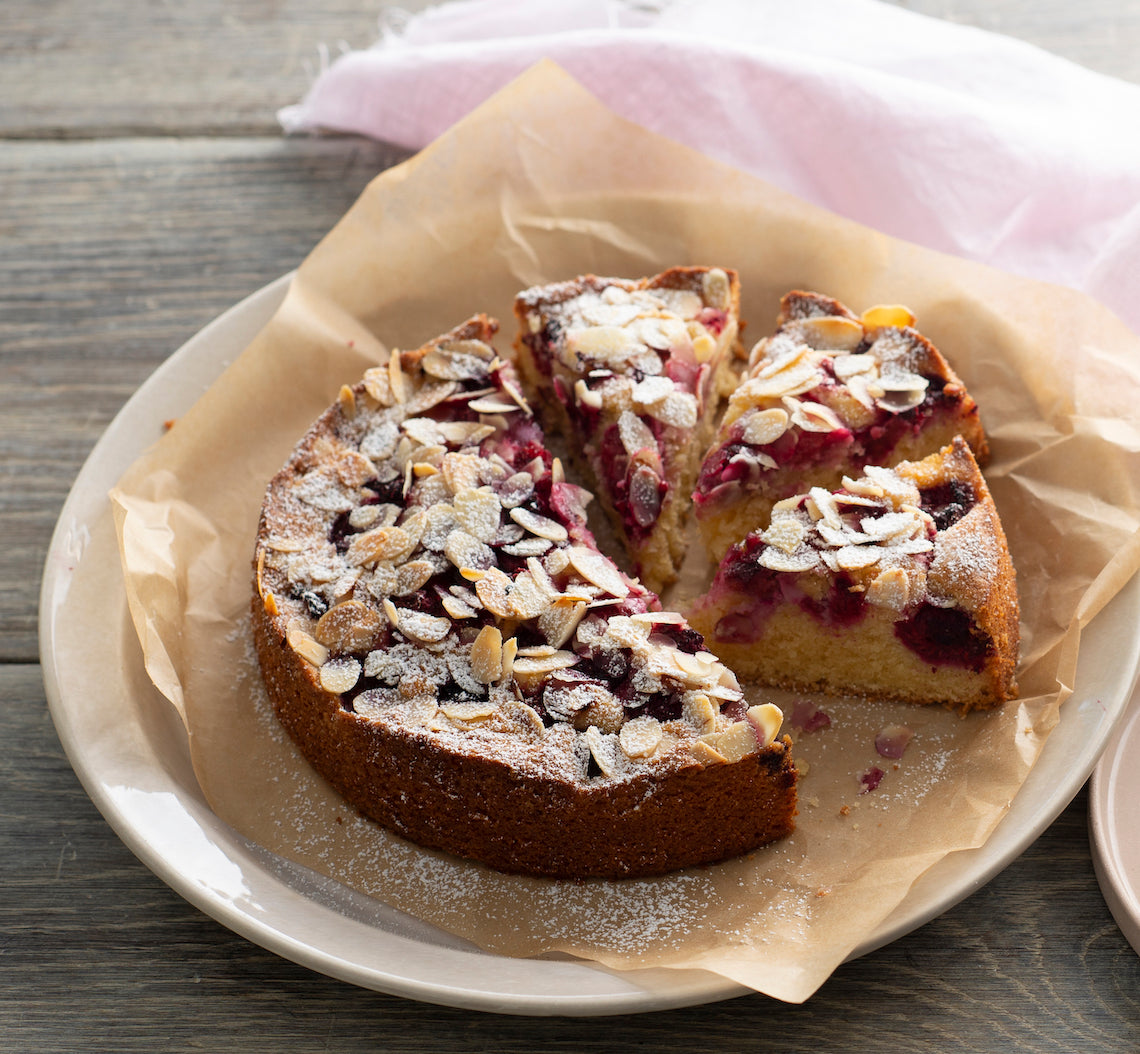
Prep 10minBake 35-40 minMakes 8-10 serves
If you are looking for a quick, easy, impressive, and not to mention delicious, cake, this is the one. Lots of clever shortcuts (like using your food processor to make it) means that this cake will be in the oven in less than 10 minutes!
Ingredients
- Melted butter, to grease
- 100g (3½oz) chilled unsalted butter, cubed
- 110g (½ cup/4oz) caster sugar
- 75g (¾ cup/2¾oz) almond meal
- 75g (½ cup/2¾oz) plain flour
- 1 teaspoon baking powder
- 2 eggs, at room temperature
- 1 teaspoon natural vanilla essence or extract
- 150g (5¼oz) fresh or frozen raspberries
- 25g (¼ cup/¾oz) flaked almonds
- Icing sugar, to dust
Method
- Preheat oven to 180°C/350°F (160°C/315°F fan-forced). Grease a 20cm/8in springform (base measurement) with the melted butter and then line the base with a piece of baking paper.
- Put the butter, sugar, almond meal, flour and baking powder in the bowl of a food processor. Process until well evenly combined and the mixture resembles fine breadcrumbs. Add the eggs and vanilla use the pulse button to process until smooth and just combined.
- Spoon the mixture into the prepared pan and smooth the surface with the back of a spoon. Sprinkle evenly with the raspberries and then use the back of a clean spoon to press the raspberries into the cake mixture. Sprinkle with the almonds.
- Bake in preheated oven for 35-40 minutes or until golden and cooked in the centre when tested with a skewer.
- Stand the cake in the pan for 5 minutes before removing the side of the pan and placing the cake (still on the base) on a wire rack. Serve warm or at room temperature dusted with icing sugar.
Baker's Tips
- The raspberries can be replaced with 150g (5¼oz) blueberries or quartered strawberries.
- For a nut-free version, the almond meal can be replaced with 75g (2¾oz) desiccated coconut and sprinkle with 25g (¼ cup/¾oz) flaked coconut.
- This cake will keep in an airtight container in a cool spot (but not in the fridge) for up to 3 days.

Prep 15minBake 16-18minMakes about 18
This shortbread had been given a little update with the addition of chia seeds. Packed with omega 3 and omega 6 fatty acids as well as loads of fibre these tiny, slightly ‘flattened’ seeds add a little ‘nutty’ crunch to this traditional favourite.
Ingredients
- 125g butter, softened
- 75g (⅓ cup) caster sugar
- 1 teaspoon natural vanilla extract or essence
- 150g (1 cup) plain flour, plus extra to dust
- 1½ tablespoons black chia seeds
Method
- Preheat oven to 160°C. Line two oven trays with non-stick baking paper.
- Put the butter, sugar and vanilla in a mixing bowl and use an electric mixer to beat until just creamy. Add the flour and chia seeds and use your hands to mix to a dough.
- Place the dough on a lightly floured surface and knead lightly until smooth. Shape into a disc and then use a lightly floured rolling pin to roll out the dough until 5mm thick. Use a 5cm round cutter to cut out biscuits and place them about 3cm apart on the trays. Re-roll any left over dough and repeat.
- Bake in preheated oven for 16-18 minutes, swapping the trays after 8 minutes, or until lightly golden and cooked through. Remove from the oven and cool on the tray
Baker's Tips
- Chia seeds are available from large supermarkets (in the health food section) and from specialty health food stores.
- These biscuits will keep in an airtight container at room temperature for up to 1 week.






